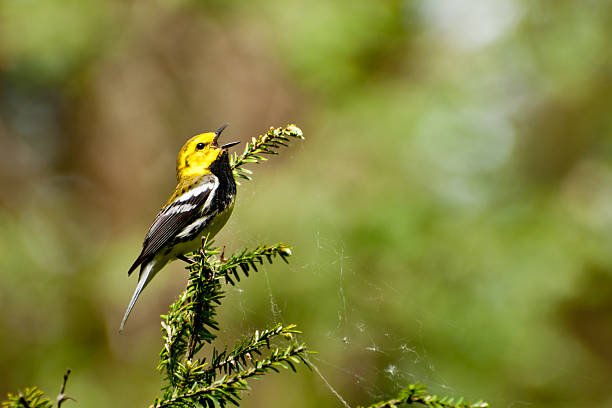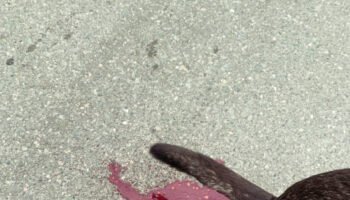Yellow Birds in NC is blessed with abundant avian beauty, and its 21 yellow bird species add a vibrant splash of color to the state’s diverse landscapes. These feathered gems come in all shapes and sizes, each with unique charm and ecological significance.
Birds are beautiful creatures that grace our skies with their presence and are vital components of healthy ecosystems. They play crucial roles in pollination, seed dispersal, and insect control, contributing to the delicate balance of nature. While technology can sometimes mimic some of these functions, there is no true substitute for the irreplaceable value of birds in our world.
Here is a list of 21 yellow birds of NC. To know more click on the bird’s name:
American Goldfinch (both sexes in summer)
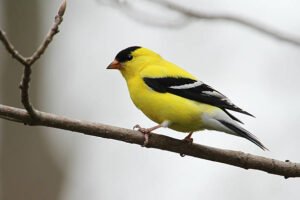 American Goldfinch: A Summer Symphony in Feathers
American Goldfinch: A Summer Symphony in Feathers
The American Goldfinch, a feathered spark of sunshine adorning summer meadows, paints the air with vibrant song and dazzling colors. Here’s a glimpse into their world:
Size:
Length: 4.5-5.5 inches (11-14 cm)
Wingspan: 8-10 inches (20-25 cm)
Weight: 0.8-1.2 ounces (23-34 grams)
Lifespan: The average lifespan in the wild is 2-3 years, though some individuals can live up to 7 years.
State bird of five US states: Iowa, Maine, New Jersey, Vermont, and Washington.
Winter Whispers:
Fall brings a transformation! The bright yellow fades to a more olive-green hue, blending seamlessly with the muted colors of the season. They still retain subtle yellow accents on their wings and face, like whispers of summer amidst the winter winds.
Summer Splendor (both sexes):
Yellow Blaze: A vibrant bright yellow body, like a splash of sunshine against the green canvas of summer. This bold hue adorns their head, throat, chest, and wing bars.
Black Accents: Black wings add a touch of drama, framing the yellow with sleek stripes. A black cap tops their head, like a tiny feathered crown.
White Underbelly: Their underside gleams with pure white, contrasting beautifully with the golden yellow above. This creates a striking color combination that is hard to miss.
Yellow Warbler (both sexes in spring and summer)
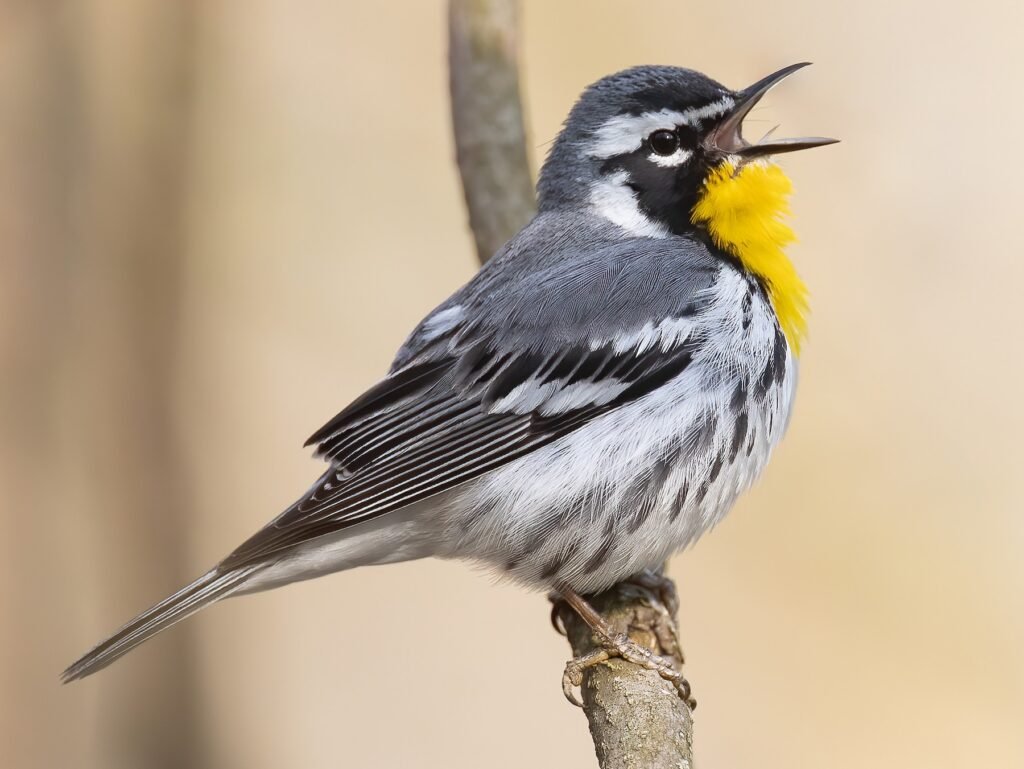 The Yellow Warbler, like a living ray of sunshine, fills the air with vibrant melodies and adorns trees with its golden glow. Here’s a peek into their bright world:
The Yellow Warbler, like a living ray of sunshine, fills the air with vibrant melodies and adorns trees with its golden glow. Here’s a peek into their bright world:
Size:
Length: 4.5-5 inches (11-14 cm)
Wingspan: 7-8.5 inches (18-22 cm)
Weight: 0.5-0.7 ounces (14-20 grams)
Lifespan: Average lifespan in the wild is 3-4 years, though some individuals can live up to 7 years.
State bird of several US states: Alabama, Florida, Illinois, Louisiana, Michigan, Minnesota, and Wisconsin.
Spring & Summer Symphony (both sexes):
Golden Burst: A vibrant yellow body dominates their plumage, like a miniature sun flitting through foliage. This rich hue covers their head, throat, chest, and back, making them impossible to miss.
Olive Accents: A touch of olive green washes over their wings and flanks, adding a subtle contrast to the golden blaze. This creates a natural camouflage amidst leafy branches.
White Touches: White stripes adorn their wing bars, adding a touch of elegance and aiding in-flight identification. White also peeks around their eyes and forms a faint ring on their neck, like a delicate necklace.
Winter’s Whisper:
Fall brings a more subdued wardrobe. The vibrant yellow fades to a softer, buffy yellow or olive green, allowing them to blend in with the browning landscape. Subtle hints of yellow remain on their wings and faces, like echoes of summer’s sunshine.
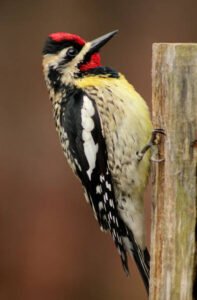 The Yellow-billed Cuckoo, a shy songbird shrouded in secrecy, adds a touch of intrigue to the leafy landscapes of North America. Here’s a glimpse into their hidden world:
The Yellow-billed Cuckoo, a shy songbird shrouded in secrecy, adds a touch of intrigue to the leafy landscapes of North America. Here’s a glimpse into their hidden world:
Size:
Length: 11-13 inches (28-33 cm)
Wingspan: 17-20 inches (43-51 cm)
Weight: 2-3 ounces (57-85 grams)
Green Guardian (both sexes):
Lifespan: Average lifespan in the wild is 4-5 years, though some individuals can live up to 7 years.
Conservation Concerns: Sadly, Yellow-billed Cuckoo populations have declined significantly due to habitat loss and pesticide use. Protecting their wetland and forest habitats is crucial for the future of this enigmatic bird.
Olive Oasis: Their body is cloaked in a soft olive-green, blending seamlessly with the foliage they call home. This muted hue covers their head, back, wings, and tail, offering perfect camouflage amidst leaves and branches.
White Whispers: Subtle white stripes adorn their wings, like whispers against the green canvas. These markings aid in flight identification and add a touch of elegance to their otherwise camouflaged plumage.
Yellow Flash: Their namesake yellow bill, long and slightly downcurved, adds a pop of color to their green attire. It’s a beacon for attentive eyes, revealing their presence even when hidden within the leafy maze.
Lifespan: Average lifespan in the wild is 4-5 years, though some individuals can live up to 7 years.
Conservation Concerns: Sadly, Yellow-billed Cuckoo populations have declined significantly due to habitat loss and pesticide use. Protecting their wetland and forest habitats is crucial for the future of this enigmatic bird.
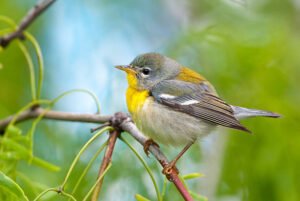 The Northern Parula, a feathered artist wielding a brush of vibrant color, adds a splash of joy to the evergreen tapestry of North American forests. Here’s a peek into their miniature masterpiece:
The Northern Parula, a feathered artist wielding a brush of vibrant color, adds a splash of joy to the evergreen tapestry of North American forests. Here’s a peek into their miniature masterpiece:
Size:
Length: 4.3-5 inches (11-13 cm)
Wingspan: 7.1-8.3 inches (18-21 cm)
Weight: 0.3-0.4 ounces (8.5-11 grams)
Lifespan: Average lifespan in the wild is 3-4 years, though some individuals can live up to 7 years.
Conservation Concerns: Northern Parula populations have declined due to habitat loss and climate change. Protecting boreal forests and mitigating climate change are crucial for the future of this tiny forest gem.
Male Magic (breeding season):
Blue Blaze: A bright blue headpiece crowns their tiny frame, like a splash of summer sky against the emerald canvas. This bold shade extends down the throat and back, making them impossible to miss amidst the green.
Yellow Accents: A band of bright yellow stretches across their breast, creating a striking contrast with the blue above. This vibrant pairing is like a miniature sunset painted on their feathers.
White Wingbar: A crisp white wingbar adds a touch of elegance and aids in identification. It’s like a delicate brushstroke against the blue canvas, highlighting their nimble wings.
Female Finesse:
Muted Melody: Females opt for a more subtle, greyish-green plumage, allowing them to blend seamlessly with the foliage. This camouflage is crucial for protecting them while raising their young.
Yellow Hints: Hints of yellow peek through on their underparts and wingbars, echoing the male’s vibrant accents. These subtle whispers of color hint at their hidden beauty.
Olive Whispers: Their back and wings are washed with a soft olive green, further camouflaging them amidst the leafy shadows. This muted palette is a masterpiece of nature’s concealment.
nt
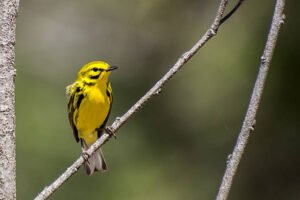 Imagine a spark of sunshine dancing through tallgrass prairies, singing a sweet melody against the whispering wind. That’s the Prairie Warbler, a feathered maestro painting fields with vibrant colors and joyful songs. Here’s a glimpse into their summer symphony:
Imagine a spark of sunshine dancing through tallgrass prairies, singing a sweet melody against the whispering wind. That’s the Prairie Warbler, a feathered maestro painting fields with vibrant colors and joyful songs. Here’s a glimpse into their summer symphony:
Size:
Length: 4.5-5 inches (11-13 cm)
Wingspan: 7-8 inches (18-20 cm)
Weight: 0.4-0.5 ounces (11-14 grams)
Lifespan: Average lifespan in the wild is 2-3 years, though some individuals can live up to 5 years.
Conservation Concerns: Prairie Warbler populations have declined due to habitat loss and fragmentation. Protecting and restoring grasslands is crucial for the future of this charismatic songbird
Male Majesty (breeding season):
Golden Blaze: A bright yellow body dominates their plumage, like a miniature sunbeam flitting amidst the swaying grasses. This bold hue covers their head, throat, chest, and back, making them impossible to miss under the summer sun.
Black Accents: Black stripes on their wings add a touch of drama, framing the yellow with elegant stripes. A black stripe extends through their eyes, like a tiny feathered mask, adding a touch of mystery.
White Whispers: White streaks adorn their underparts and wing bars, creating a striking contrast and aiding in-flight identification. These delicate brushstrokes complement the vibrant yellow, like sunlight dappling through the summer meadow.
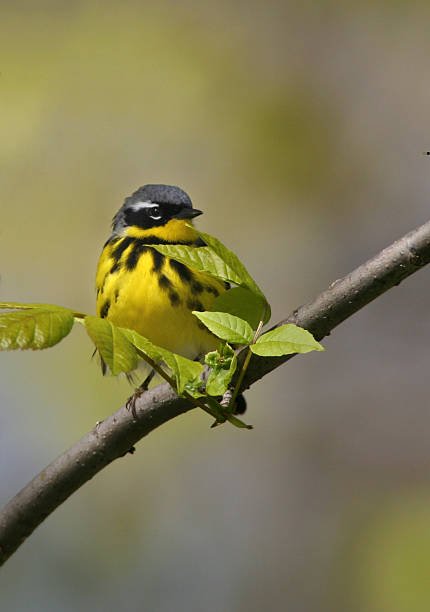 Imagine a feathered artist dipped in sunshine, painting streaks of yellow brilliance across the green canvas of the forest. That’s the Magnolia Warbler, a male masterpiece radiating charm and captivating song amidst the leafy boughs. Here’s a glimpse into their vibrant presence:
Imagine a feathered artist dipped in sunshine, painting streaks of yellow brilliance across the green canvas of the forest. That’s the Magnolia Warbler, a male masterpiece radiating charm and captivating song amidst the leafy boughs. Here’s a glimpse into their vibrant presence:
Size:
Length: 4.7-5.5 inches (12-14 cm)
Wingspan: 7.5-8.7 inches (19-22 cm)
Weight: 0.5-0.7 ounces (14-20 grams)
Male Majesty (breeding season):
Yellow Blaze: A vibrant yellow chest dominates their plumage, like a splash of liquid sunlight against the emerald backdrop. This bold shade extends up their throat and onto their face, making them impossible to miss amidst the foliage.
Black Accents: Bold black streaks frame their yellow chest, forming a striking bib that adds drama and definition. Black also streaks down their flanks and wings, like calligraphic brushstrokes against the golden canvas.
White Underbelly: Their underside gleams with pure white, contrasting beautifully with the vibrant yellow above. This creates a striking color combination that is hard to miss, even while flitting through the branches.
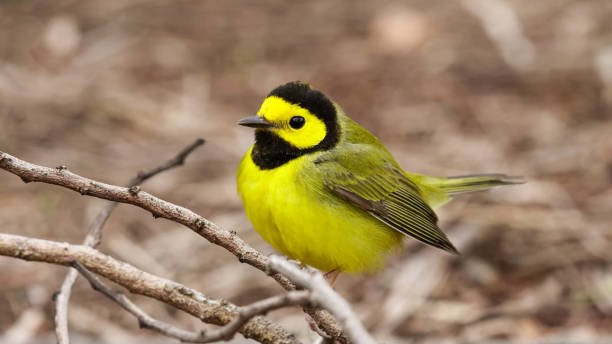 Imagine a feathered bandit hiding a secret splash of yellow beneath a sleek black hood, serenading the forest with a sweet, whistled melody. That’s the Hooded Warbler, a captivating songbird painting the green depths with vibrant personality and hidden charm. Here’s a glimpse into their masked masterpiece:
Imagine a feathered bandit hiding a secret splash of yellow beneath a sleek black hood, serenading the forest with a sweet, whistled melody. That’s the Hooded Warbler, a captivating songbird painting the green depths with vibrant personality and hidden charm. Here’s a glimpse into their masked masterpiece:
Size:
Length: 4.7-5.5 inches (12-14 cm)
Wingspan: 7.5-8.7 inches (19-22 cm)
Weight: 0.4-0.6 ounces (11-17 grams)
Lifespan: Average lifespan in the wild is 3-4 years, though some individuals can live up to 7 years.
Conservation Concerns: Hooded Warbler populations have declined due to habitat loss and fragmentation. Protecting mature forests and reducing pesticide use are crucial for the future of this masked maestro.
Male Majesty (breeding season):
Hooded Hero: A black hood drapes over their head, like a feathered mask adding mystery and intrigue. This striking feature instantly sets them apart amidst the leafy canvas.
Yellow Blaze: Hidden beneath the hood, a vibrant yellow chest peeks out like a burst of sunshine. This flash of color adds warmth and unexpected cheer to their otherwise masked persona.
Green Accents: Their back and wings are washed with a soft olive green, allowing them to blend seamlessly with the surrounding foliage. This camouflage is crucial for protection while foraging and nesting.
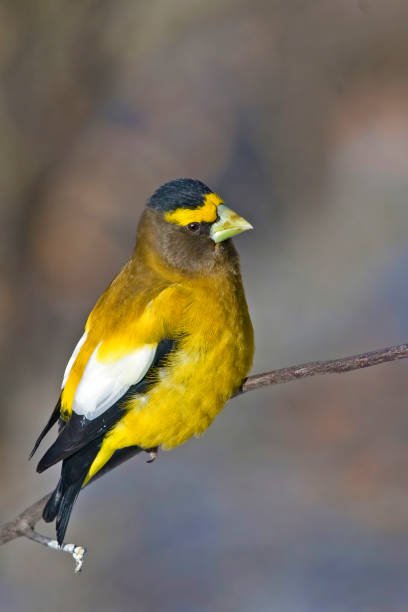 Imagine a feathered monarch draped in a cloak of gold, surveying his forest kingdom from the twilight branches. Enter the Evening Grosbeak, a male masterpiece captivating the evening skies with vibrant flashes of color and a commanding presence. Let’s unravel the secrets of his majestic plumage:
Imagine a feathered monarch draped in a cloak of gold, surveying his forest kingdom from the twilight branches. Enter the Evening Grosbeak, a male masterpiece captivating the evening skies with vibrant flashes of color and a commanding presence. Let’s unravel the secrets of his majestic plumage:
Size:
Length: 8-9 inches (20-23 cm)
Wingspan: 13-16 inches (33-41 cm)
Weight: 2-3 ounces (57-85 grams)
Lifespan: Average lifespan in the wild is 4-5 years, though some individuals can live up to 10 years.
Conservation Concerns: Evening Grosbeak populations have declined due to habitat loss and climate change. Protecting mature forests and providing supplemental food sources during harsh winters are crucial for the future of this regal songbird.
Golden Glow (breeding season):
Sunlit Crown: A vibrant yellow head crowns his stately frame, like a splash of liquid sunshine against the darkening sky. This radiant hue extends down his throat and onto his chest, making him impossible to miss amidst the fading light.
Black Accents: Bold black stripes frame his yellow crown and bib, adding a touch of drama and definition. Black also streaks down his wings and flanks, like calligraphic brushstrokes against the golden canvas.
White Underbelly: His underside gleams with pure white, contrasting beautifully with the vibrant yellow above. This creates a striking color combination that is especially noticeable as the last rays of sun filter through the trees.
Yellow-throated Warbler (males)
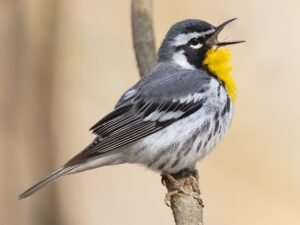 Imagine a feathered jewel radiating sunshine from its throat, flitting through sun-dappled forests like a living melody. That’s the Yellow-throated Warbler, a male masterpiece painting the emerald tapestry of woodlands with vibrant splashes of color and captivating song. Let’s explore the secrets of his miniature masterpiece:
Imagine a feathered jewel radiating sunshine from its throat, flitting through sun-dappled forests like a living melody. That’s the Yellow-throated Warbler, a male masterpiece painting the emerald tapestry of woodlands with vibrant splashes of color and captivating song. Let’s explore the secrets of his miniature masterpiece:
Size:
Length: 4.3-5 inches (11-13 cm)
Wingspan: 7-8 inches (18-20 cm)
Weight: 0.3-0.4 ounces (8.5-11 grams)
Lifespan: Average lifespan in the wild is 3-4 years, though some individuals can live up to 7 years.
Conservation Concerns: Yellow-throated Warbler populations have declined due to habitat loss and fragmentation. Protecting mature forests and minimizing pesticide use are crucial for the future of this tiny sunbeam of the songbird world.
Male Majesty (breeding season):
Golden Throat: A vibrant yellow patch adorns his throat like a tiny sunbeam against the backdrop of green leaves. This radiant hue extends slightly onto his chest, making him impossible to miss amidst the dappled sunlight.
Grey Accents: His head and back are washed with a cool slate grey, blending seamlessly with the shadows and branches. This contrasting balance creates a striking harmony between the boldness of his throat and the subtlety of his surroundings.
Black Touches: Black stripes frame his yellow throat and bib, adding a touch of definition and drama. Black also streaks down his wings and flanks, like calligraphic brushstrokes against the canvas of nature.
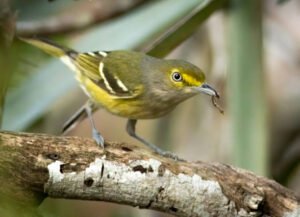 Imagine a feathered sentry draped in olive armor, flitting through dense foliage with a cheery, infectious song. That’s the White-eyed Vireo, a compact powerhouse guarding the secrets of the trees with watchful eyes and a bouncing rhythm. Let’s explore the secrets within its miniature kingdom:
Imagine a feathered sentry draped in olive armor, flitting through dense foliage with a cheery, infectious song. That’s the White-eyed Vireo, a compact powerhouse guarding the secrets of the trees with watchful eyes and a bouncing rhythm. Let’s explore the secrets within its miniature kingdom:
Size:
Length: 4.3-5.1 inches (11-13 cm)
Wingspan: 7.1-8.3 inches (18-21 cm)
Weight: 0.4-0.5 ounces (11-14 grams)
Lifespan: Average lifespan in the wild is 4-5 years, though some individuals can live up to 8 years.
Conservation Concerns: White-eyed Vireo populations have declined due to habitat loss and fragmentation. Protecting mature forests and minimizing pesticide use are crucial for the future of this tiny guardian of the greenery.
Green Guardian (both sexes):
Olive Oasis: Their body is cloaked in a soft olive green, blending seamlessly with the leafy canvas they call home. This muted hue covers their head, back, wings, and tail, offering perfect camouflage amidst the branches.
White Eyering: Their namesake white eye rings stand out like beacons in the green foliage, making them easily identifiable even when hidden within the leaves. These bright circles add a touch of personality and alertness to their otherwise muted attire.
Yellow Accents: Subtle hints of yellow peek through on their underparts and wingbars, adding a touch of warmth and vibrancy to their otherwise earthy palette. These delicate brushstrokes hint at the inner cheerfulness that fuels their bouncing melody.
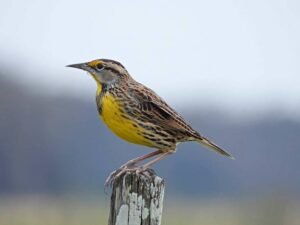 Imagine a feathered conductor perched atop a swaying grass stalk, baton of sunshine outstretched as it leads the windblown orchestra of its meadow kingdom. That’s the Eastern Meadowlark, a maestro of vibrant song and dazzling plumage, painting the canvas of open spaces with its joyous presence. Let’s explore the secrets hidden within its golden wings:
Imagine a feathered conductor perched atop a swaying grass stalk, baton of sunshine outstretched as it leads the windblown orchestra of its meadow kingdom. That’s the Eastern Meadowlark, a maestro of vibrant song and dazzling plumage, painting the canvas of open spaces with its joyous presence. Let’s explore the secrets hidden within its golden wings:
Size:
Length: 9-11 inches (23-28 cm)
Wingspan: 15-19 inches (38-48 cm)
Weight: 3-4 ounces (85-113 grams)
Lifespan: Average lifespan in the wild is 2-3 years, though some individuals can live up to 7 years.
Conservation Concerns: Eastern Meadowlark populations have declined due to habitat loss and fragmentation. Protecting grasslands and minimizing pesticide use are crucial for the future of this maestro of the meadows.
Male Majesty (breeding season):
Golden Blaze: A bright yellow breast dominates their plumage, like liquid sunshine spilled onto the earth. This vibrant hue extends up their throat and onto their face, making them impossible to miss amidst the swaying grasses.
Black Accents: Bold black stripes frame their yellow chest and bib, adding a touch of drama and definition. Black also decorates their wings and back, like calligraphic brushstrokes against the golden canvas.
White Underbelly: Their underside gleams with pure white, contrasting beautifully with the vibrant yellow above. This creates a striking color combination that sets them apart as they sing from their grassy podium.
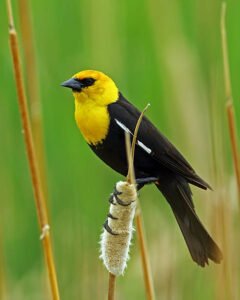 Imagine a dapper gentleman clad in a midnight suit, suddenly bursting into a raucous, infectious cackle. That’s the Yellow-headed Blackbird, a charismatic contradiction where bold sunshine meets mischievous charm, painting the marshes and fields with vibrant personality and boisterous song. Let’s explore the secrets hidden beneath his shiny black hood:
Imagine a dapper gentleman clad in a midnight suit, suddenly bursting into a raucous, infectious cackle. That’s the Yellow-headed Blackbird, a charismatic contradiction where bold sunshine meets mischievous charm, painting the marshes and fields with vibrant personality and boisterous song. Let’s explore the secrets hidden beneath his shiny black hood:
Size:
Length: 9-11 inches (23-28 cm)
Wingspan: 15-19 inches (38-48 cm)
Weight: 3-4 ounces (85-113 grams)
Lifespan: Average lifespan in the wild is 2-3 years, though some individuals can live up to 8 years.
Conservation Concerns: Yellow-headed Blackbird populations have declined due to habitat loss and wetland degradation. Protecting wetlands and minimizing pesticide use are crucial for the future of this charismatic splash of sunshine in a feathered tuxedo.
Male Majesty (breeding season):
Golden Crown: A vibrant yellow head sits atop his sleek black body, like a splash of sunshine crowning a tuxedoed king. This radiant hue extends down his throat and chest, making him impossible to miss amidst the reeds and cattails.
Midnight Mantle: His back, wings, and tail are draped in a deep, glossy black, creating a striking contrast with his golden crown. This dramatic combination gives him an air of elegance and mischief, hinting at the playful spirit hidden beneath his regal exterior.
Scarlet Accents: On his shoulders, hidden beneath the black cloak, a flash of scarlet red peeks through, like a secret passion burning bright. This unexpected touch adds a touch of hidden fire to his otherwise balanced palette
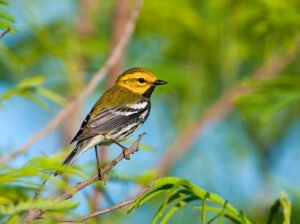 Toggle
Toggle
Imagine a feathered emerald flitting through sun-dappled woodlands, its tiny throat adorned with a splash of midnight. That’s the Black-throated Green Warbler, a miniature masterpiece painting the forest tapestry with vibrant flashes of color and a hidden treasure of song. Let’s explore the secrets beneath its shimmering green cloak:
Size:
Length: 4.3-5 inches (11-13 cm)
Wingspan: 7-8 inches (18-20 cm)
Weight: 0.3-0.4 ounces (8.5-11 grams)
Lifespan: Average lifespan in the wild is 4-5 years, though some individuals can live up to 8 years.
Conservation Concerns: Black-throated Green Warbler populations have declined due to habitat loss and climate change. Protecting mature forests and mitigating climate change are crucial for the future of this tiny emerald jewel with a hidden melody.
Male Majesty (breeding season):
Emerald Glory: Their body is cloaked in a rich, glossy green, blending seamlessly with the leaves and branches. This vibrant hue covers their head, back, wings, and tail, making them appear almost invisible amidst the foliage.
Black Bib: A sleek black bib adorns their throat, like a splash of ink against the emerald canvas. This bold contrast adds a touch of drama and definition, drawing attention to their tiny frame.
White Wingbars: Distinct white wingbars decorate their wings, aiding in flight identification and adding a touch of elegance to their otherwise monochromatic plumage. These subtle highlights hint at the hidden beauty that unfolds when they take flight.
Yellow-bellied Sapsucker (males)
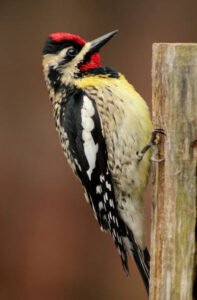 Imagine a feathered drummer clad in a crimson beret, tapping out a rhythmic tattoo against the canvas of ancient trees. That’s the Yellow-bellied Sapsucker, a male masterpiece painting the woodlands with vibrant flashes of color and the echoing pulse of his percussive serenade. Let’s explore the secrets hidden beneath his bold attire:
Imagine a feathered drummer clad in a crimson beret, tapping out a rhythmic tattoo against the canvas of ancient trees. That’s the Yellow-bellied Sapsucker, a male masterpiece painting the woodlands with vibrant flashes of color and the echoing pulse of his percussive serenade. Let’s explore the secrets hidden beneath his bold attire:
Size:
Length: 7-8.7 inches (18-22 cm)
Wingspan: 13-16 inches (33-41 cm)
Weight: 2-3 ounces (57-85 grams)
Lifespan: Average lifespan in the wild is 3-4 years, though some individuals can live up to 7 years.
Conservation Concerns: Yellow-bellied Sapsucker populations have declined due to habitat loss and fragmentation. Protecting mature forests and maintaining dead trees are crucial for the future of this drumming drummer in a scarlet cap.
Male Majesty (breeding season):
Scarlet Headband: A bright crimson crown adorns their head, like a splash of molten lava against the backdrop of green. This eye-catching hue extends down their throat, making them impossible to miss as they drum their way through the trees.
Black Bib: A sleek black bib extends from their chin down their chest, framing the scarlet like a bold accent. This contrasting combination adds a touch of drama and definition, drawing attention to their energetic drumming performances.
Yellow Belly: Their underside is ablaze with a vibrant yellow, like sunshine captured in feathers. This contrasting splash against the black and red creates a striking color palette that announces their presence from afar.
White Wingbars: Distinct white wingbars decorate their black wings, aiding in flight identification and adding a touch of elegance to their otherwise dramatic plumage. These subtle highlights hint at the agile grace that unfolds when they take flight.
 Imagine a feathered dandy adorned in a bohemian cloak, festooned with crimson jewels and crowned with a rakish crest. That’s the male Cedar Waxwing, a master of casual elegance painting the winter skies with flashes of color and a melodic lullaby for the snow-kissed trees. Let’s explore the secrets hidden beneath his layered attire:
Imagine a feathered dandy adorned in a bohemian cloak, festooned with crimson jewels and crowned with a rakish crest. That’s the male Cedar Waxwing, a master of casual elegance painting the winter skies with flashes of color and a melodic lullaby for the snow-kissed trees. Let’s explore the secrets hidden beneath his layered attire:
Size:
Length: 6.7-7.9 inches (17-20 cm)
Wingspan: 11-13 inches (28-33 cm)
Weight: 1.3-1.8 ounces (37-51 grams)
Lifespan: Average lifespan in the wild is 3-4 years, though some individuals can live up to 7 years.
Conservation Concerns: Cedar Waxwing populations are relatively stable, but habitat loss and pesticide use can impact their food sources. Protecting berry-bearing trees and using natural pest control methods are crucial for the future of this bohemian dandy draped in crimson jewels
Male Majesty (breeding season):
Bohemian Brown: Their body is cloaked in a soft, dusty brown, blending seamlessly with the muted winter landscapes. This understated hue serves as the perfect canvas for the vibrant accents to come.
Crimson Crest: A bold splash of crimson adorns their head, like a feathered crown perched atop their bohemian cloak. This eye-catching splash draws attention and adds a touch of regal flair to their otherwise humble attire.
Black Mask: A sleek black mask surrounds their eyes, adding a touch of mystery and intrigue to their persona. This contrasting feature makes their bright eyes stand out, hinting at their sharp vision and watchful nature.
Jewels of Wax: Tiny, red, waxy tips adorn the end of their wing feathers, like scattered jewels sewn onto their feathered cloak. These unique decorations not only add a touch of whimsical elegance but also help them withstand the frigid temperatures of winter.
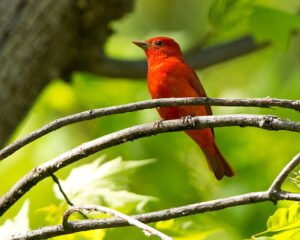 Imagine a feathered flame painting the green tapestry of the forest with vibrant strokes of crimson. That’s the male Summer Tanager, a masterpiece of avian beauty whose fiery plumage and melodious song announce the arrival of warm summer days. Let’s explore the secrets hidden beneath his scarlet cloak:
Imagine a feathered flame painting the green tapestry of the forest with vibrant strokes of crimson. That’s the male Summer Tanager, a masterpiece of avian beauty whose fiery plumage and melodious song announce the arrival of warm summer days. Let’s explore the secrets hidden beneath his scarlet cloak:
Size:
Length: 5.5-6.3 inches (14-16 cm)
Wingspan: 9.1-10.2 inches (23-26 cm)
Weight: 0.7-1 ounce (20-28 grams)
Lifespan: Average lifespan in the wild is 4-5 years, though some individuals can live up to 8 years.
Conservation Concerns: Summer Tanager populations are relatively stable, but habitat loss and pesticide use can impact their food sources. Protecting mature forests and minimizing pesticide use are crucial for the future of this scarlet splash in the emerald canopy.
Male Majesty (breeding season):
Scarlet Splendor: Their entire body is engulfed in a rich, vibrant scarlet, like liquid fire poured onto feathers. This eye-catching hue extends from their head down to their tail, making them impossible to miss amidst the green foliage.
Black Wings: Bold black wings frame their scarlet expanse, adding a touch of definition and drama to their fiery form. This contrasting combination creates a visually striking silhouette, especially when they take flight.
White Wingbars: Distinct white wingbars decorate their black wings, aiding in flight identification and adding a touch of elegance to their otherwise monochromatic plumage. These subtle highlights hint at the agile grace that unfolds when they take to the sky.
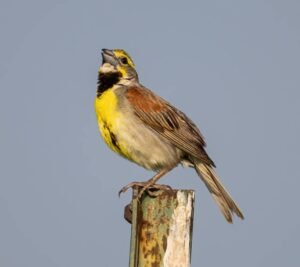 Imagine a feathered conductor perched atop a swaying cornstalk, baton of sunshine outstretched as it leads the windblown orchestra of the prairie. That’s the Dickcissel, a maestro of vibrant melody and bold plumage, painting the canvas of open grasslands with its joyous presence. Let’s explore the secrets hidden beneath its striped suit:
Imagine a feathered conductor perched atop a swaying cornstalk, baton of sunshine outstretched as it leads the windblown orchestra of the prairie. That’s the Dickcissel, a maestro of vibrant melody and bold plumage, painting the canvas of open grasslands with its joyous presence. Let’s explore the secrets hidden beneath its striped suit:
Size:
Length: 6.3-7.5 inches (16-19 cm)
Wingspan: 11-13 inches (28-33 cm)
Weight: 1-1.3 ounces (28-37 grams)
Lifespan: Average lifespan in the wild is 2-3 years, though some individuals can live up to 7 years.
Conservation Concerns: Dickcissel populations have declined due to habitat loss and fragmentation. Protecting grasslands and minimizing pesticide use are crucial for the future of this field maestro in yellow and black stripes.
Male Majesty (breeding season):
Golden Sunburst: A bright yellow breast dominates their plumage, like liquid sunshine spilled onto the earth. This vibrant hue extends up their throat and onto their face, making them impossible to miss amidst the swaying grasses.
Black Bib & Stripes: Bold black stripes frame their yellow chest and bib, adding a touch of drama and definition. Black also decorates their wings and back, like calligraphic brushstrokes against the golden canvas.
Chestnut Shoulders: A warm chestnut patch adorns their shoulders, like a splash of autumn amidst the vibrant yellow and black. This unexpected touch adds a touch of depth and character to their otherwise striking plumage.
 Imagine a feathered flame dancing through the leafy shadows, its vibrant hues defying the muted tones of the forest. That’s the male American Redstart, a miniature meteor painting the green canvas with splashes of scarlet and black, its energetic movements echoing with a melodic symphony. Let’s explore the secrets hidden beneath its fiery cloak:
Imagine a feathered flame dancing through the leafy shadows, its vibrant hues defying the muted tones of the forest. That’s the male American Redstart, a miniature meteor painting the green canvas with splashes of scarlet and black, its energetic movements echoing with a melodic symphony. Let’s explore the secrets hidden beneath its fiery cloak:
Size:
Length: 4.3-5.1 inches (11-13 cm)
Wingspan: 7.1-8.3 inches (18-21 cm)
Weight: 0.3-0.5 ounces (8.5-14 grams)
Lifespan: Average lifespan in the wild is 2-3 years, though some individuals can live up to 7 years.
Conservation Concerns: American Redstart populations have declined due to habitat loss and fragmentation. Protecting mature forests and maintaining diverse undergrowth are crucial for the future of this fiery flash in the green labyrinth.
Male Majesty (breeding season):
Scarlet Blaze: Their body is adorned with a rich, blazing scarlet, like molten lava spilling through the greenery. This vibrant hue covers their head, back, wings, and tail, making them impossible to miss as they flit through the branches.
Black Wings & Bib: Bold black wings frame their fiery form, adding a touch of drama and definition. This contrasting combination creates a visually striking silhouette, especially when they take flight. A sleek black bib further defines their chest, hinting at their energetic pursuit of prey.
White Wingbars: Distinct white wingbars decorate their black wings, aiding in flight identification and adding a touch of elegance to their otherwise fiery plumage. These subtle highlights hint at the agile grace that unfolds when they take to the sky.
Imagine a feathered emerald adorned with a necklace of fiery rubies, flitting through sun-dappled woodlands with a melody as charming as its jewels. That’s the male Canada Warbler, a tiny masterpiece painting the forest tapestry with vibrant flashes of color and a hidden serenade for the rustling leaves. Let’s explore the secrets hidden beneath its shimmering cloak:
Size:
Length: 5.1-5.9 inches (13-15 cm)
Wingspan: 7.9-8.7 inches (20-22 cm)
Weight: 0.4-0.5 ounces (11-14 grams)
Lifespan: Average lifespan in the wild is 4-5 years, though some individuals can live up to 8 years.
Conservation Concerns: Canada Warbler populations have declined due to habitat loss and fragmentation. Protecting mature forests and maintaining diverse understories are crucial for the future oMale Majesty (breeding season):
Emerald Majesty: Their body is cloaked in a rich, shimmering green, like sunlight filtered through the canopy. This vibrant hue covers their head, back, wings, and tail, making them blend seamlessly with the leafy maze.
Fiery Necklace: A striking band of black flecked with crimson adorns their throat and chest, like a necklace of rubies against the emerald expanse. This unexpected splash of color draws attention and adds a touch of regal charm to their otherwise understated attire.
Yellow Underparts: A soft yellow washes over their underside, hinting at the hidden sunshine beneath their leafy cloak. This subtle touch adds a hint of warmth and contrast to their overall palette.f this gemstone in a necklace of green.
Black-throated Green Warbler (wing bars)
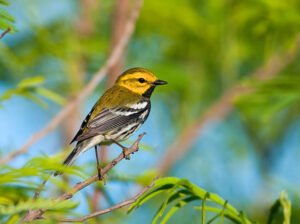 Focusing solely on the wing bars of the Black-throated Green Warbler can be helpful for initial identification, but appreciating its full splendor requires a look at its complete feathered attire and enchanting melody. So, let’s paint a vibrant picture of this miniature emerald with a hidden song:
Focusing solely on the wing bars of the Black-throated Green Warbler can be helpful for initial identification, but appreciating its full splendor requires a look at its complete feathered attire and enchanting melody. So, let’s paint a vibrant picture of this miniature emerald with a hidden song:
Size:
Length: 4.3-5 inches (11-13 cm)
Wingspan: 7-8 inches (18-20 cm)
Weight: 0.3-0.4 ounces (8.5-11 grams)
Color:
Head & Back: A rich, shimmering green, like sunlight filtered through a pristine forest canopy. This vibrant hue blends seamlessly with the leafy labyrinth, making them masters of camouflage.
Black Bib: A sleek black bib adorns their throat, extending down their chest like a splash of ink against the emerald canvas. This contrasting touch adds a touch of drama and definition to their otherwise understated attire.
Yellow Underparts: A soft yellow washes over their underside, hinting at the hidden sunshine beneath their leafy cloak. This subtle touch adds a warmth and contrast to their overall palette.
Wingbars: Ah, the key features! Distinct white wingbars decorate their black wings, aiding in flight identification and adding a touch of elegance to their otherwise earth-toned plumage. These subtle highlights hint at the agile grace that unfolds when they take to the sky.
Average lifespan in the wild is 4-5 years, though some individuals can live up to 8 years.
Protecting mature forests and maintaining diverse understories are crucial for the future of this tiny emerald with a hidden song.
Summer Tanager (wing markings)
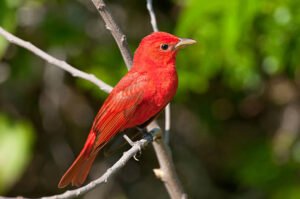 Focusing solely on the wing markings of the Summer Tanager, while potentially helpful for initial identification, might not be the most effective way to appreciate its vibrant beauty and captivating presence. To truly understand this feathered masterpiece, let’s delve into its full-fledged splendor:
Focusing solely on the wing markings of the Summer Tanager, while potentially helpful for initial identification, might not be the most effective way to appreciate its vibrant beauty and captivating presence. To truly understand this feathered masterpiece, let’s delve into its full-fledged splendor:
Size:
Length: 5.5-6.3 inches (14-16 cm)
Wingspan: 9.1-10.2 inches (23-26 cm)
Weight: 0.7-1 ounce (20-28 grams)
Color:
A Sea of Scarlet: The star of the show! Their entire body explodes with a rich, vibrant scarlet, like liquid fire poured onto feathers. This eye-catching hue covers their head, back, wings, and tail, making them impossible to miss amidst the green summer foliage.
Black Wings & Tail: Bold black wings frame their fiery form, adding a touch of drama and definition. This contrasting combination creates a visually striking silhouette, especially when they take flight.
White Wingbars: Ah, the wing markings! Distinct white wingbars decorate their black wings, aiding in flight identification and adding a touch of elegance to their otherwise monochromatic plumage. These subtle highlights hint at the agile grace that unfolds when they take to the sky.
Average lifespan in the wild is 4-5 years, though some individuals can live up to 8 years.
Protecting mature forests and minimizing pesticide use are crucial for the future of this scarlet splash in the emerald canopy.
Here are some additional facts about yellow birds in NC that you may find interesting:
⦁ The state is home to more than 400 bird species in total, making it a birding paradise.
⦁ The Great Smoky Mountains National Park is a hotspot for yellow birds, with species like the Blackburnian Warbler, the Hooded Warbler, and the Cerulean Warbler found in its high-elevation forests.
⦁ The coastal plain of North Carolina is home to a number of unique yellow birds, such as the Pine Warbler and the Prairie Warbler.
conclusion:
These are just a few of the many captivating yellow birds that call North Carolina home. Each species contributes to the intricate web of life, ensuring a healthy ecosystem and enriching our lives with their beauty and song. By appreciating these feathered treasures and protecting their habitats, we can help ensure their continued presence in the Tar Heel State for generations to come.

